
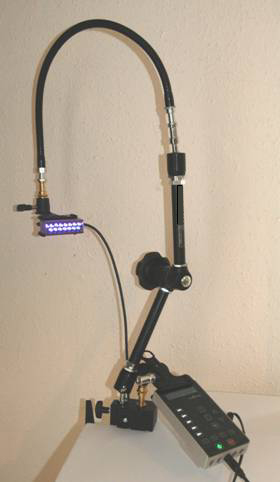
medlouxx- PDT device system
Photodynamic Therapy is the local excitation of exogenous applied chromophores by uv,-visible or infrared electromag- netic radiation with the purpose to destroy selectively cells and tissue of the organism, bacterias, viruses or fungi.*
* the photodynamic therapy is recognized by school medicine
Non-oncologic inidications are neovascularisation of the eyes, actinic ceratoses, wound healing disorders, accompanied or caused by bacterial infections, viral and fungal infections.
In PDT a photosensitive substance (photosensitizer) ia applied systemically or locally. Due to different metabolic rates, the photosensitizer accumulates in cancer cells and tissue or in bacterias or fungi. The resulting concentration gradient of the photosensitizers between normal tissue and the target tissue allows the selective phototoxic elimination of the target cells and tissue. The irradiation by light of appropriate wavelenght and in the presence of molecular oxygen, leads to photochemical reactions, which create reactive oxygen species. The lifetime and diffusion length of the ROS is large enough to react with cellular compartments to induce necrosis or apoptosis of the targets.
The PDT is a selective and -when correctly perfomed- a highly effectiv treatment modality .
The desired treatment result are usually reached after 1-2 treatments.
The photodynamic diagnosis (PDD) is based on the excitation of fluorescence radiation in the photosensitizer and therefore, can be used before the PDT treatment to localize the target tissue and to confine the targets and after the PDT treatment to control the photochemical status of the target tissue.
The most frequently used photosensitizers in PDT presently belongs to the group of porphyrines. By exogenous/ topical application of the precursor 5 -alpha -levulinic acid (5-ALA), which is not photosensitive, the photosensitive Protoporphyrin IX (Pp9) is accumulated in the cells. Pp9 is the target molecul of the photodynamic irradiation, which absorbes strongly at 405 nm ( blue radiation) and at 630 and 670 nm (red radiation) . The irradiation by one of these wavelengths leads to the photochemical reactions descirbed above.
A new group of photosensitizers with improved selectivity are the chlorines, which also belong to the prophyrine structures. The chlorines absorb at 660 nm (red radiation) , the similar bacterio-chlorines show absorption bands at 760 nm ( infrared radiation) .The chlorines can be intravenous applied or directly injected into the tumor or topically used.
- The medlouxx-PDT devices emit 665 nm (red radiation) or 405 nm (violett radiation) of high intensity. The optical output power of the medlouxx radiation heads is of about 2-5 Watt, the power density is of about 350 mW/cm². All the important photosensitizer described above can be effectively exited by the medlouxx -PDT radiation heads. In a 5-10 min long treatment between 100-200 J/cm² are transferred to the tissue. In contrast to PDT with Lasers, the medlouxx illuminates an area of about 10 cm² homogenously !
- Due to the fact that medlouxx- PDT devices are emitting monochromatic non -coherent radiation, significant advantages regarding treatment safety and treatment costs are resulting, compared to laser-PDT.
The improved transparency of the medlouxx radiation in human tissue, based on the EIT effect, allows larger penetration depths and action depths, so that deeper in tissue located targets can be destroyed.
All medlouxx-PDT devices are equipped with a violet laser channel and a handpiece for perfoming photodynamic diagnostics (PDD).
Effective PDT-treatments are reported for :
1. Infection diseases
bacterial infectiones by Porphyromonas gingivalis, Propioni b acterium acnes , Staphylococcus aureus, Pseudomonas aeruginosa , Heliobacter Pylori , Prevotella intermedia, Fusobacterium nucleatum, Myobacterium tuberculosis : Gingivitis, Osteomyelitis
fungal infections by Candida Albigans, Trichophyton rubum:
Onychomycosis, Vaginalmycosis
2. Dermatology: sBCC, nBCC, actinic ceratosis, acne, psoriasis,
Vitiligo, Lichen ruber
3. neovascular eye diseases: wet AMD
4. cance of the lungth
5. cancer of the gastrointestinal Tract
6. cancer of head and neck
7. wound healing disorders: diabetic foot ulcus
8. skin regeneration: anti-aging treatments
.

PDT of actinic ceratosis with 5-ALA
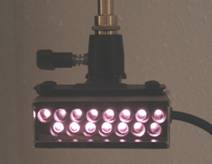
medlouxx-PDT radiation head 660 nm
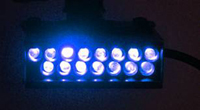
medlouxx-PDT radiation head 405 nm
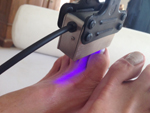
Photodynamic treatment
of toonail fungus infection by
5-ALA
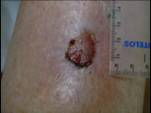
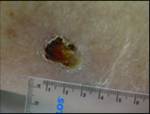
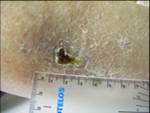
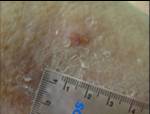
Photodynamic treatment of a
bacterial infected, therapy resistent , chronic diabetic foot ulcus
by Chlorin - PDT